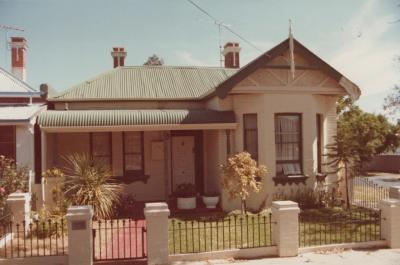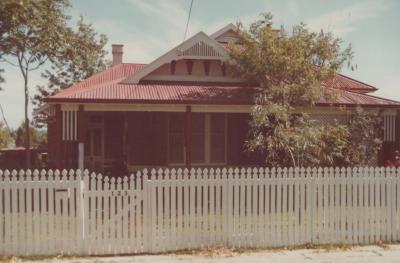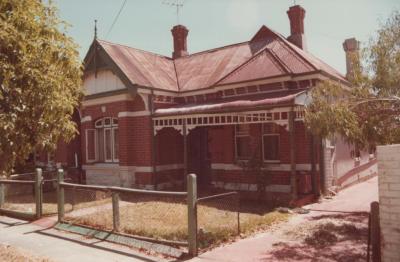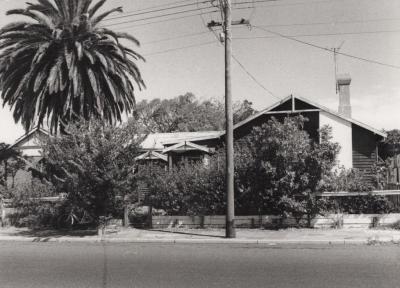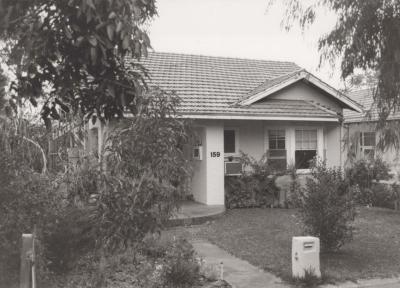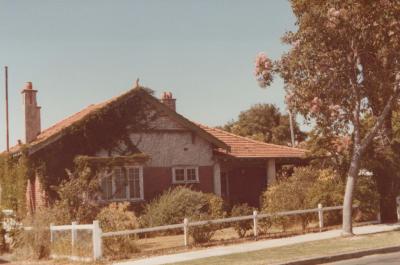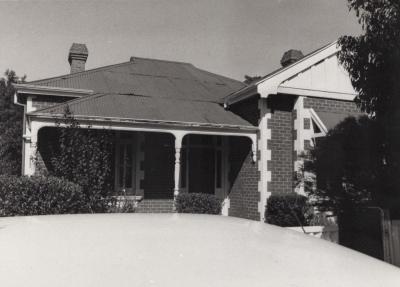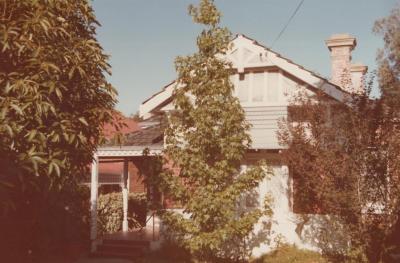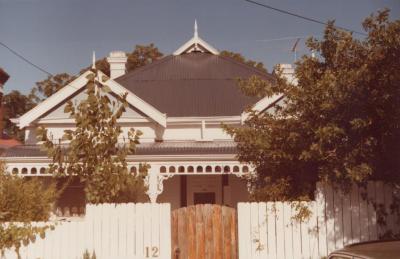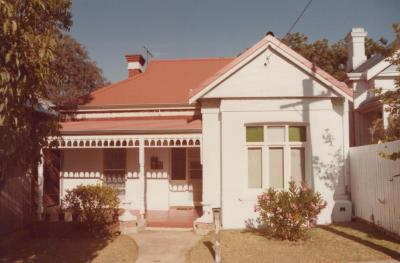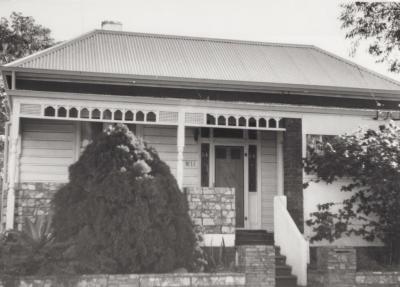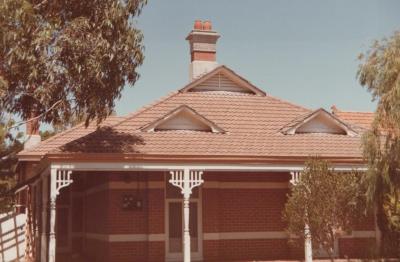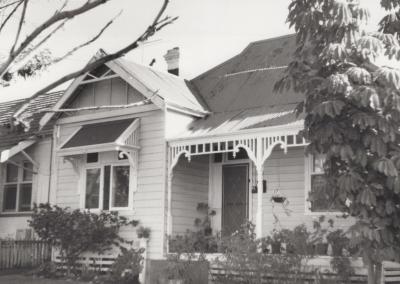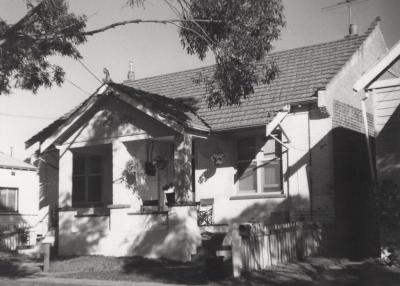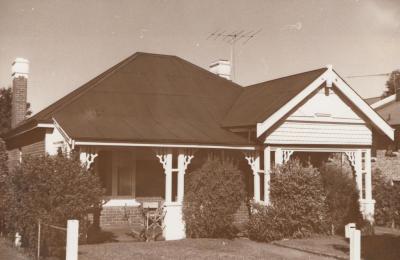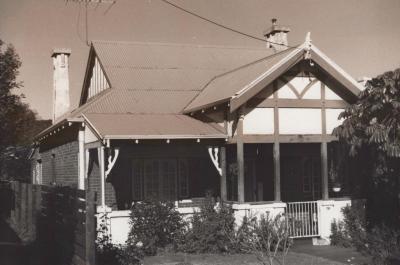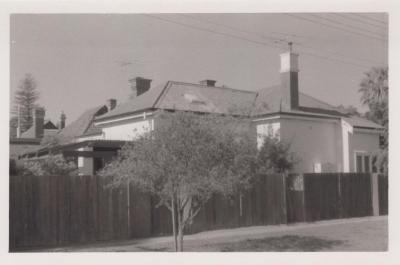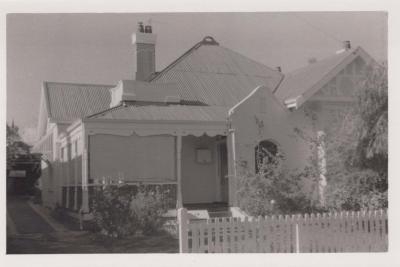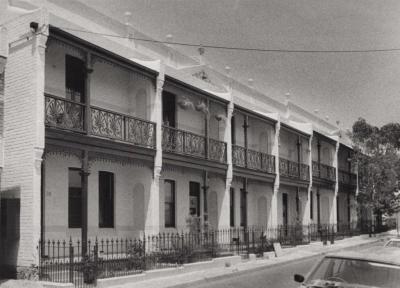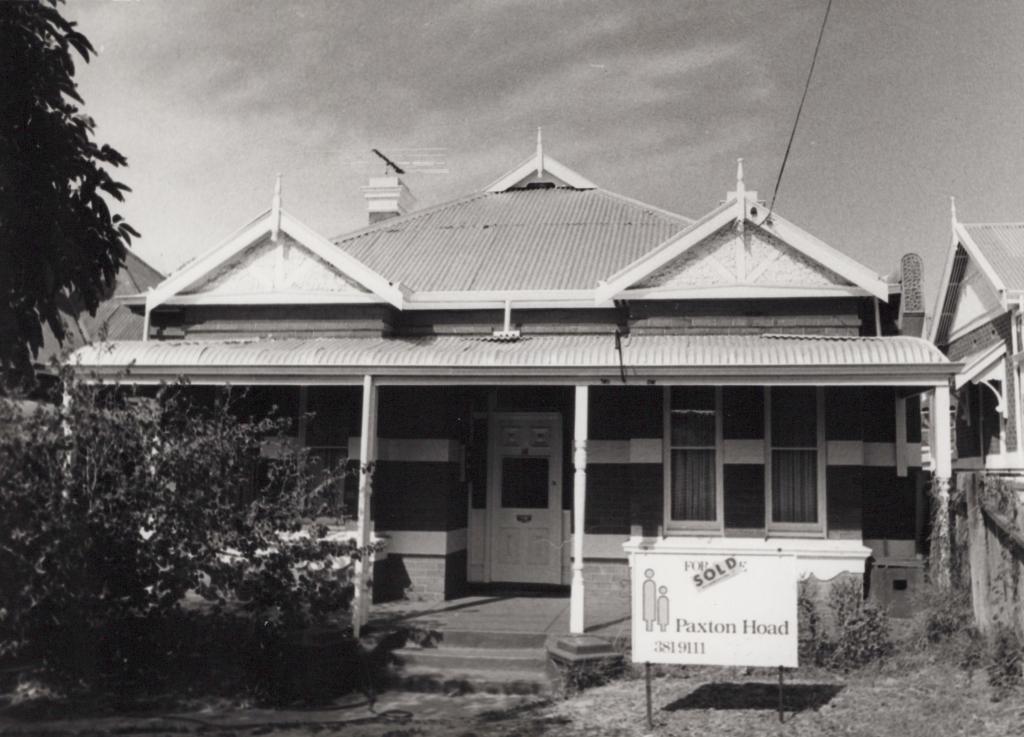PHOTOGRAPH: 16 KINGS ROAD, NATIONAL ESTATE SURVEY COLLECTION
1985Black and white photograph of a house at 16 Kings Road. The house is symmetrical. It is made of bricks. There are two horizontal white painted stripes across the front façade of the house. There is a chimney with an electrical antenna attached. There is a small gable with a finial fixed on top at the top of the roof. There are two larger gables right above the roof of the verandah. Those gables also have finials fixed on top. There is a bull nosed verandah with a tin roof supported by decorated wooden beams. The main entrance is in the middle of the image. There are three steps leading up to the main entrance. There are two tall rectangular windows to the right of the main entrance. There is a sign on the grass patch in front of the house reading 'SOLD Paxton Hoad 3819111'. There are bushes and trees partially covering the left part of the house. There is a neighbouring house to the right with a pitched gable roof. There is a finial fixed on top of the gable. This house is als made of bricks. A fence is separating the main house from the house to the right.
Reverse: Written on the reverse in pencil '16 KINGS ROAD.'
From a series of photographs taken by Ian Molyneux for the National Estate Survey of Subiaco in 1985.
The house was constructed from 1906.
On 13 March 1883, the Western Australian government announced it would survey a section of the Perth Commonage into suburban lots and that these would then be made available for private sale. This subdivision had created 141 residential allotments with frontages to the southern side of Bagot Road, eastern side of Townsend Road, north-western side of Thomas Street, northern side of Hamersley Road, and to both sides of Francis Street, Park Street (now Kings Road) and Market Street (now part Bedford Avenue). By 1906, measures were being taken to ensure that Kings Road (together with adjacent streets) was developed with good quality housing. In January it was reported that Kings Road was one of several local streets where preparations were in place for providing a permanent water supply via extensions to the water mains; while in September, it was reported that it was one of several streets that had been topped with limestone ballast. Development then progressed rapidly with a further 8 houses being built in 1906-1908: 6, 7, 8, 11, 12, 14, 16 & 25. After a short hiatus, the remainder of the street was gradually developed over an 11 year period.
Details
Details
Ian Molyneux
From a series of photographs taken by Ian Molyneux for the National Estate Survey of Subiaco in 1985.
Other items by Ian Molyneux
- PHOTOGRAPH: 12 UNION STREET, NATIONAL ESTATE SURVEY COLLECTION
- PHOTOGRAPH: 85 HEYTESBURY ROAD, NATIONAL ESTATE SURVEY COLLECTION
- PHOTOGRAPH: 123 HEYTESBURY ROAD, NATIONAL ESTATE SURVEY COLLECTION
- PHOTOGRAPH: 247 ROBERTS ROAD, NATIONAL ESTATE SURVEY COLLECTION
- PHOTOGRAPH: 75 OLIVE STREET, NATIONAL ESTATE SURVEY COLLECTION
- PHOTOGRAPH: 81 OLIVE STREET, NATIONAL ESTATE SURVEY COLLECTION
- PHOTOGRAPH: 151 BAGOT ROAD, NATIONAL ESTATE SURVEY COLLECTION
- PHOTOGRAPH: 159 GLOSTER STREET, NATIONAL ESTATE SURVEY COLLECTION
- PHOTOGRAPH: UNKNOWN HOUSE BAGOT ROAD, NATIONAL ESTATE SURVEY COLLECTION
- PHOTOGRAPH: 178 PARK STREET, NATIONAL ESTATE SURVEY COLLECTION
- PHOTOGRAPH: 92 HEYTESBURY ROAD, NATIONAL ESTATE SURVEY COLLECTION
- PHOTOGRAPH: UNKNOWN HOUSE COGHLAN ROAD, NATIONAL ESTATE SURVEY COLLECTION
Other items from Subiaco Museum
- PHOTOGRAPH: 6 KINGS ROAD, NATIONAL ESTATE SURVEY COLLECTION
- PHOTOGRAPH: 12 KINGS ROAD, NATIONAL ESTATE SURVEY COLLECTION
- PHOTOGRAPH: 10 KINGS ROAD, NATIONAL ESTATE SURVEY COLLECTION
- PHOTOGRAPH: 11 SMYTH ROAD, NATIONAL ESTATE SURVEY COLLECTION
- PHOTOGRAPH: 20 UNION STREET, NATIONAL ESTATE SURVEY COLLECTION
- PHOTOGRAPH: 17 SMYTH ROAD, NATIONAL ESTATE SURVEY COLLECTION
- PHOTOGRAPH: 19 SMYTH ROAD, NATIONAL ESTATE SURVEY COLLECTION
- PHOTOGRAPH: 17 KEIGHTLEY ROAD EAST, NATIONAL ESTATE SURVEY COLLECTION
- PHOTOGRAPH: 15 KEIGHTLEY ROAD EAST, NATIONAL ESTATE SURVEY COLLECTION
- PHOTOGRAPH: UNKNOWN HOUSE KEIGHTLEY ROAD EAST, NATIONAL ESTATE SURVEY COLLECTION
- PHOTOGRAPH: 14 AUSTIN STREET, NATIONAL ESTATE SURVEY COLLECTION
- PHOTOGRAPH: 18-32 CATHERINE STREET, NATIONAL ESTATE SURVEY COLLECTION

